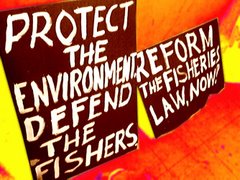Recall of Japanese Mining Company’s ECC Urged
The Central Visayas Fisherfolk Development Center together with several small fisherfolk organizations in Cebu City have reiterated a long-standing demand for the recall of the Environmental Compliance Certificate issued by the Environmental Management Bureau-Central Visayas to the Japan Petroleum Exploration Co., Ltd.
BY KARL G. OMBION
Bulatlat
Vol. VII, No. 36, October 14-20, 2007
The Central Visayas Fisherfolk Development Center (FIDEC) together with several small fisherfolk organizations in Cebu City have reiterated a long-standing demand for the recall of the Environmental Compliance Certificate (ECC) issued by the Environmental Management Bureau (EMB)-Central Visayas to the Japan Petroleum Exploration Co., Ltd. (JAPEX).
FIDEC executive director Vince Cinches, in a recent interview, said they want JAPEX’s ECC recalled because it violates the National Integrated Protected Areas System (NIPAS) Act, environmental impact assessment (EIA) laws, and the Fisheries Code of the Philippines.
The Department of Energy (DoE) Visayas Field Office recently announced that it will start oil exploration in Tanon Strait, in partnership with JAPEX, in November this year.
DoE Visayas Field Office Director Antonio Labios said they approved the JAPEX oil drilling project with a 1.5 kilometer territorial water radius in the Tanon Strait after the DENR granted it an ECC.
Areas to be affected by the oil exploration include most towns in mid-north and southwestern Cebu and on the Negros side, from Escalante City in Negros Occidental to as far as Sibulan town in Negros Oriental.
Environmental law violations
Cinches said the EMB must recall JAPEX’s ECC because of the company’s failure to conduct public hearings and consultations and other similar activities to present its environmental impact statement (EIS) for proper appreciation – a requirement, he said, since the EIA should study the ecological, geophysical and socio-economic impacts of the preparatory, operational and decommissioning phases of the activity.
Cinches cited Sec. 9 of Presidential Decree No. 1586, or the decree establishing an EIS System, which states that:
“Any person, corporation or partnership found violating Section 4 of this Decree, or terms and conditions in the issuance of the Environmental Protection Council pursuant to this Decree shall be punished by the suspension or cancellation of his/its certificate or and/or a fine in an amount not to exceed Fifty Thousand Pesos (50,000.00) for every violation thereof, at the discretion of the National Environmental Protection Council.”
The conduct of an EIA is a requirement under Philippine law. Sec. 4 of Presidential Decree No. 1151, or Philippine Environmental Policy, provides that “all agencies and instrumentalities of the national government, including government-owned or controlled corporations, as well as private corporations, firms and entities shall prepare, file and include in every action, project or undertaking which significantly affects the quality of the environment a detailed statement on:
“a. the environmental impact of the proposed action, project or undertaking;
“b. any adverse environmental effect which cannot be avoided should the proposal be implemented;
“c. alternative to the proposed action;
“d. a determination that the short-term uses of the resources of the environment are consistent with the maintenance and enhancement of the long-term productivity of the same; and
“e. whenever a proposal involves the use of depletable or nonrenewable resources, a finding must be made that such use and commitment are warranted.
Cinches also said that the DOE and EMB violated the NIPAS Law. “We note that the project is part (of) and within the Tanon Strait, (a) protected seascape under Presidential Decree No. 1234,” he said. “As such, the activity will also be governed by Republic Act No.7586, the National Integrated Protected Areas System (NIPAS) Act.”
Section 20 of the NIPAS Act provides that “except as may be allowed by the nature of their categories and pursuant to rules and regulations governing the same, the following acts are prohibited within protected areas:
“(a) Hunting, destroying, disturbing, or mere possession of any plants or animals or products derived therefrom without a permit from the protected area management board;
“(b) Dumping of any waste products detrimental to the protected area, or to the plants and animals or inhabitants therein;
“(c) Constructing or maintaining any kind of structure fences or enclosures, conducting any business enterprise without a permit.”
Section 12 of the NIPAS Act further provides that:
“Proposals for activities which are outside the scope of the management plan for protected areas shall be subject to an environmental impact assessment as required by law before they are adopted, and the results thereof shall be taken into consideration in the decision making process. No actual implementation of such activities shall be allowed without the required ECC under the Philippine EIA system…”
Aside from violating the EIA laws and the NIPAS Act, Cinches said, JAPEX’s ECC also violates the Fisheries Code of the Philippines which protects the municipal waters – in this case the waters of Toledo City, Pinamungahan and Aloguinsan towns in Tanon Strait’s Cebu side, and Guihulngan and Vallehomoso towns in the Negros side – from the intrusion of offshore mining projects.
“This kind of project destroys the marine biodiversity, fish stocks, water pollution, air pollution, oil spills, and worse, the deprivation of small artisan fisherfolk from their main sources of livelihood,” Cinches said.
“We condemned DoE for pursuing the project despite evidences gathered during our environmental investigative mission (EIM) that the seismic survey conducted (in) 2005 has resulted in dramatic reduction of fish catch, also it resulted in fish kill, and health problems in the southwestern part of Cebu, particularly Toledo, Pinamungajan, and Aloguinsan,” he added. “Tourism activities such as dolphin watching and diving (in Bais and Cebu) were affected.”
He said that two years after their EIM, various marine species have yet to return for the season and fish catch continues to decline especially in Pinamungajan, Aloguinsan and Vallehermoso.
He slammed EMB for withholding related documents such as EIS, EIA and other bases for granting an ECC to JAPEX despite repeated formal requests from their office.
He however said that a copy of the said ECC which they got from former Environment Secretary Angel Alcala revealed that the DoE and EMB had only done initial environmental examination (IEE) of the impact of the project and not the complete and thorough EIS and EIA. “This is a serious deception and should be penalized,” he said.
In a separate statement, Alcala – who now heads Silliman University’s Angelo King Center for Research and Environmental Management – said the DoE and EMB’s survey of Tanon Strait “was extremely rapid, lacking in critical data essential for valid and meaningful comparisons in order to determine the impacts of the exploratory drilling.”
“It is clear that DoE and EMB are in cahoots with various environmentally destructive corporations when they decided to push through with seismic surveys last year,” Cinches said. “They are pushing for marine rehabilitation and protection while pursuing offshore mining.”
Socio-environmental costs
Cinches reiterated his group’s stand that offshore mining should be banned in the Visayas since the activity “will have great repercussions on marine supply, food security, local economy, and will dislocate thousands of already impoverished fisherfolk.”
Cinches also said that offshore mining “will strengthen the control of foreign monopoly corporations over our resources, since the service contract awarded to JAPEX will allow them 100-percent ownership and control on prospecting, mine development, and extraction.”
Cinches said that they are mobilizing the broadest network possible to resist and halt the JAPEX-DoE oil drilling in Tanon Strait. Bulatlat





No comments:
Post a Comment